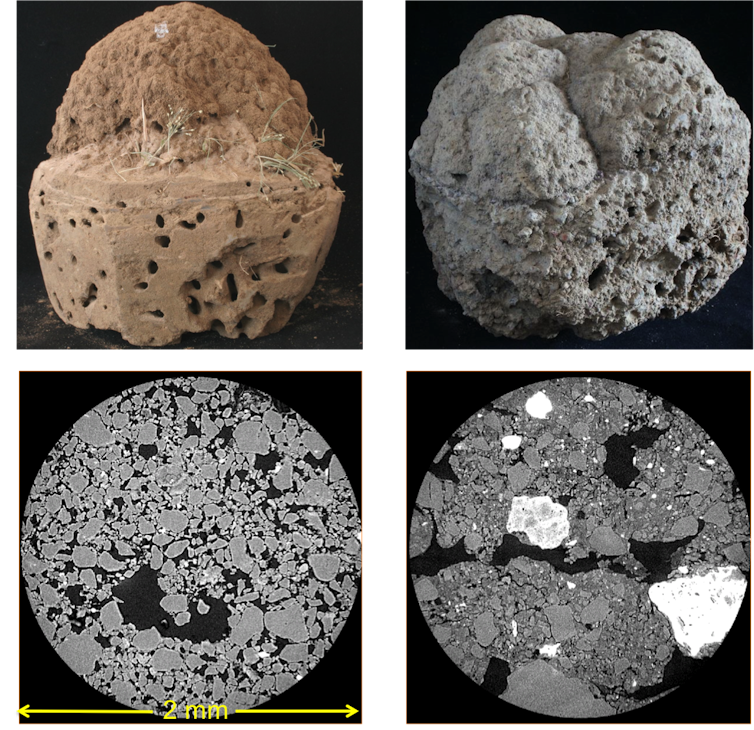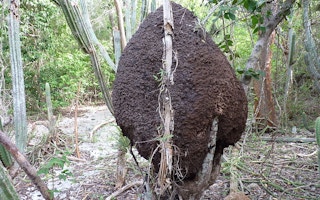When it comes to building sustainable buildings, humans have a lot to learn from termites. A recent study that colleagues and I published in Science Advances explains how some African termites maintain cool and stable temperatures in their nests throughout the year.
The answer lies in the wall of the nests, composed of tiny but highly-connected pores.
Today’s architects and builders are continuously seeking new and improved ways to cool buildings without using more energy. In fact, growing demand for air conditioners is one of the most critical blind spots in today’s energy debate—it has been projected that 10 new air-conditioning units will be sold every second for the next 30 years.
As, the planet warms, people will increasingly need to build sustainable buildings that do not rely on vast amounts of energy for air conditioning.
This is where termites come in. Termites—not to be confused with their distant relatives, ants—are insects with sophisticated social structures built on hierarchies—they have kings, queens, workers and soldiers. Like humans, these cockroach cousins prefer to build their own environment rather than adapting to one. For example, some termites have mastered sustainable fungus farming which helps them digest their food.
One can also find termites living in arid regions that may be hostile to their bodies. To counteract this harsh environment (and in some cases to sustain fungus farming) they build structures that are sufficiently cool and humid—these are the famous mounds, or nests.
For these reasons, termite nests have been widely studied as examples of effective ventilation and temperature control. Yet, exactly how they build their constructions has until recently remained somewhat poorly understood.
Different termite different mechanism
Some species of termites, those that do farm fungus, build towering nests that are ventilated by a complex system of tunnels and openings. These tunnels regulate the nests’ ventilation the same way chimneys and windows work in a human house.
In fact, a few buildings have been inspired by termite nests, such as the Eastgate Centre in Zimbabwe which successfully uses 90 per cent less energy than a similarly sized building next door.
Structure is key to the nests’ ventilation
That’s what colleagues and I—a team of biologists, engineers, and mathematicians in France and the UK—set out to investigate. Our research found that the tiny building blocks that make up the nests itself are optimised for these processes to occur naturally and effectively.
We focused on a non-fungus-growing species, the grass harvesting termite, and began by excavating nests we found in Senegal and Guinea in West Africa. The nests are made of soil particles mixed with water and termite saliva. Despite not having apparent openings, the walls are composed of micrometre-sized pores.

We took tiny samples from the nests and put them under a micro X-ray scanner akin to that used in hospitals—but one which is capable of scanning with much finer resolutions. This revealed the termites build outer walls that actually contain both small pores and a series of slightly larger and interconnected pores. In fact, about 99 per cent of the pore space was linked up.
Using the X-ray scans, we were able to build a digital version of the nests, much like the digital worlds that exist in computer games. We then simulated the nests in the conditions in which these termites live – dry in Senegal and wetter in Guinea.
We found that the links between the big pores allows air to “percolate” through the outer wall in the same way coffee is strained through a filter. This is key to ventilation and regulating temperatures.
By creating tiny ventilation passages, the pores of the nests manage gas exchange in a similar way to human lungs. But where a pair of lungs deflates and inflates to drive ventilation, in these nests the air is driven in and out by differences in temperature between the inner nest and the outside world.
We still don’t know whether termites create these interconnected pores following simple construction rules, or as a consequence of physical constraints resulting from the way pellets of soil are packed together. But our research does suggest that it is the structure, not the material used, that is key to ventilation. Especially considering that samples from the two regions are composed predominantly of different materials (sand in Senegal and clay in Guinea).
The challenge is now to derive the same design principles and scale them up for humans. No one wants to live in an exact copy of a termite’s nest, complete with fungus chambers. But learning from termites might involve creating new synthetic building materials with connected pores.
It is important to remember that human ingenuity allows us to not merely copy forms found in nature, but to emulate the mechanism by which such forms emerge.
Bagus Putra Muljadi is an assistant professor in Chemical and Environmental Engineering, University of Nottingham, UK. This article was originally published on The Conversation.









